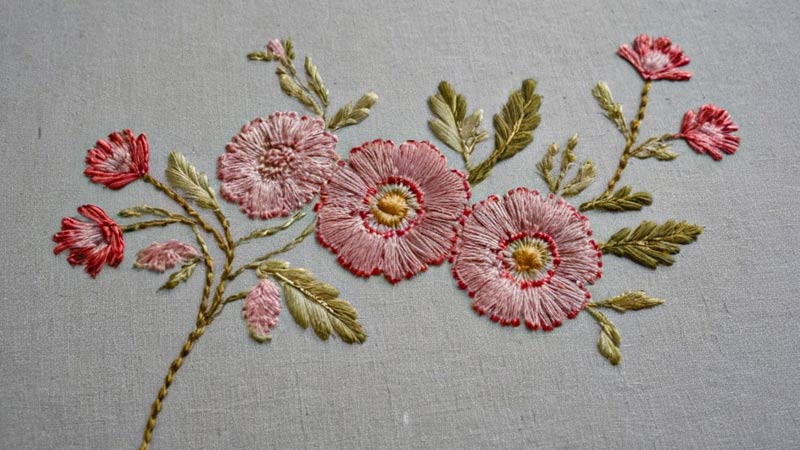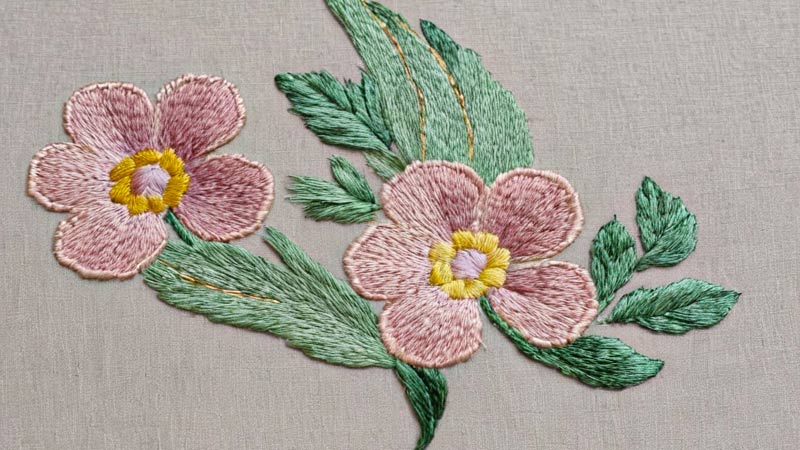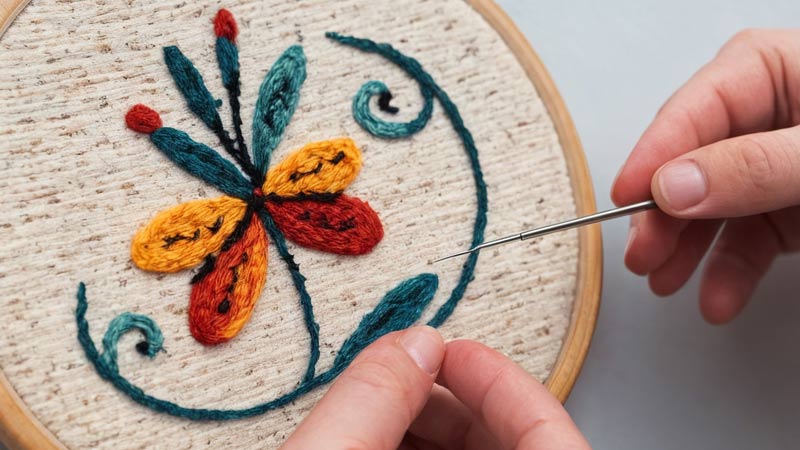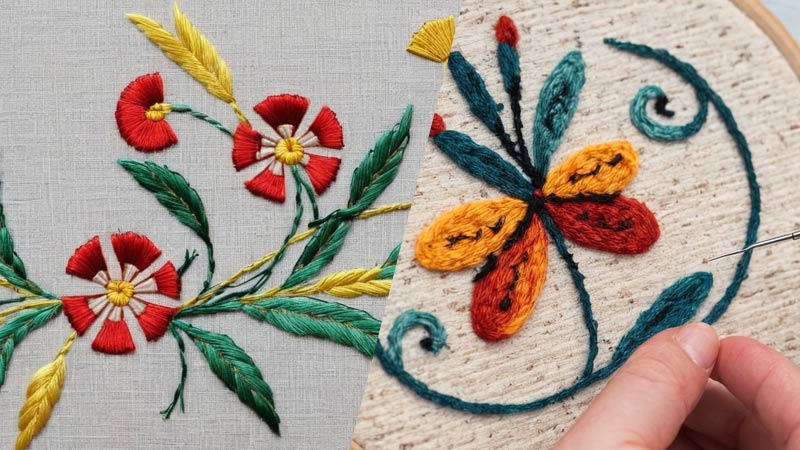Bunka embroidery, a traditional Japanese craft known for its intricate and vibrant designs, relies on specialized threads to bring its unique creations to life.
The ideal thread for bunka embroidery is typically made of silk or rayon, chosen for its sheen, durability, and ability to hold intricate stitches.
These threads come in many colors, allowing artists to capture the richness and detail inherent in Japanese cultural motifs.
The carefully selected threads enhance the visual appeal of bunka embroidery and contribute to the craft’s longevity, ensuring that the finished pieces stand as testaments to the artistry and precision inherent in this cherished Japanese needlework tradition.

What Thread Is Used for Bunka Embroidery?
Bunka embroidery, a traditional Japanese needlework technique, relies on a unique thread known as Kayo, commonly marketed as “bunka thread” outside Japan.
This distinctive thread is crafted from rayon, a synthetic fiber renowned for its lustrous appearance and smooth texture.
The rayon thread enhances the visual appeal of bunka embroidery, contributing to the creation of intricate and vibrant designs.
The specialized Kayo thread is designed to be used with a punch needle in the bunka embroidery process. The flexible chain-stitched thread allows for precise and intricate detailing in the artwork.
This rayon thread’s characteristics make it well-suited for replicating the fine, elaborate stitches integral to bunka embroidery.
Its sheen and pliability add a luxurious touch to the finished pieces, reminiscent of the material used to craft decorative and graduation tassels.
As an essential element in bunka embroidery, the rayon thread not only facilitates the technical aspects of the craft but also plays a crucial role in elevating the aesthetic quality of the final creations.
Characteristics of Bunka Thread
Bunka thread, also known as Kayo, is a specialized thread explicitly designed for Bunka embroidery, a traditional Japanese needlework technique.
This unique thread possesses several characteristics that make it well-suited for creating intricate and visually appealing designs:
Flexibility

Bunka thread stands out for its exceptional flexibility, a crucial characteristic that facilitates Bunka embroidery’s intricate and elaborate nature.
The thread’s suppleness allows artists to execute complex stitches, curves, and fine details precisely.
This flexibility is essential in capturing the flowing lines and nuanced patterns often found in traditional Japanese designs, making Bunka thread well-suited for the meticulous artistry associated with this embroidery technique.
Texture
The distinct texture of Bunka thread is a defining feature that contributes to Bunka embroidery’s unique visual and tactile appeal.
As the thread is worked into the fabric using a punch needle, it creates a raised, textured surface that enhances the overall depth and intricacy of the design.
This textured effect adds a layer of sophistication to the finished piece, capturing the essence of traditional Japanese art and craft.
Sheen
Composed primarily of rayon, Bunka thread exhibits a subtle and attractive sheen. This luminous quality adds a touch of elegance to the embroidered surface, creating a play of light and shadow that highlights the intricate details.
The sheen enhances the embroidery’s visual appeal and contributes to the dynamic and vibrant presentation of colors in Bunka designs.
Vibrant Colors

Bunka thread boasts a broad spectrum of vibrant colors, allowing artists to infuse their creations with rich, dynamic hues.
The extensive color palette captures the vivid and traditional color schemes prevalent in Japanese art.
The availability of such a diverse range of colors empowers artists to express their creativity and create visually striking Bunka embroidery pieces that reflect the cultural richness of Japan.
Smoothness
The smooth texture of Bunka thread ensures a seamless stitching process. As the needle glides effortlessly through the fabric, artists can achieve clean, well-defined lines in their embroidery.
This smoothness enhances the work’s overall quality and facilitates a more enjoyable and controlled stitching experience, allowing for greater precision in realizing intricate Bunka patterns.
Durability
The composition of the Bunka thread, primarily consisting of durable rayon fibers, ensures the longevity of the embroidery. This durability is crucial for maintaining the structural integrity of Bunka designs over time.
The thread’s resilience allows finished pieces to withstand the test of time, making them suitable for display and preservation as cherished artifacts of Japanese needlework.
Varied Thickness
Bunka thread is available in various thicknesses or weights, providing artists with versatility in their creative endeavors.
The availability of different thickness options allows for adapting Bunka thread to various styles and scales of embroidery.
Artists can choose thinner threads for delicate, intricate designs or opt for thicker threads to create bold, expressive patterns, showcasing the adaptability of Bunka thread to diverse artistic visions.
How Do You Thread a Bunka Needle? Step-By-Step Guide

Threading a bunka needle is a simple yet essential task for anyone engaged in bunka embroidery or other related crafts.
Bunka needles are commonly used in Japanese embroidery and are known for their unique hooked or curved shape, which makes them well-suited for creating intricate and detailed stitches.
Here’s a step-by-step guide on how to thread a bunka needle:
Materials Needed:
- Bunka needle
- Bunka thread (silk or rayon threads are commonly used)
- Scissors
Steps to Thread a Bunka Needle:
Prepare the Bunka Thread
When selecting the bunka thread for your project, consider the color that complements your design. The rich palette of bunka threads allows for a wide range of creative possibilities.
Once you’ve chosen, cut a practical length of thread, typically between 18 to 24 inches. The length can vary based on your comfort and the complexity of your embroidery pattern.
Ensure a clean edge by using sharp scissors to trim the end of the thread, minimizing the risk of fraying.
Identify the Needle Eye
Carefully examine the bunka needle to locate the eye, a small opening near the pointed end. Unlike traditional needles, bunka needles often feature an eye on the curved or hooked part.
Take a moment to familiarize yourself with the needle’s unique design before moving on to threading.
Hold the Needle Properly
Grasp the Bunka needle confidently, focusing on the pointed end while securing a firm grip on the curved or hooked section.
Position the needle so the eye is easily accessible for threading. A stable hold ensures a smoother and more efficient threading process.
Thread the Needle
With the Bunka needle securely in your hand, take the trimmed end of the thread and gently guide it through the eye.
Due to the curved or hooked shape of bunka needles, you may need to angle the thread slightly to facilitate a seamless pass through the eye.
Patiently pull the thread until you have an even amount on both sides of the needle, preparing it for your embroidery endeavors.
Secure the Thread
Tie a small knot at the end opposite the needle to prevent the thread from slipping through the eye while you work.
This simple yet crucial step ensures that your thread remains anchored, allowing you to concentrate on the precision of your stitches without interruptions.
Trim Excess Thread
After securing the thread, assess whether any excess extends from the needle. Using scissors, carefully trim any surplus thread, leaving an adequate length for your embroidery work.
A tidy and well-maintained thread ensures a smooth stitching process, allowing you to focus on the artistic aspects of your bunka embroidery.
Bunka Embroidery vs Punch Needle

Embroidery enthusiasts often explore various techniques to express their creativity, and two popular methods that stand out are Bunka Embroidery and Punch Needle. Both techniques offer unique approaches to creating textured and visually appealing designs.
Let’s delve into the characteristics of each, highlighting the distinctions between Bunka Embroidery and Punch Needle:
Bunka Embroidery vs. Punch Needle: A Comparative Overview
| Aspect | Bunka Embroidery | Punch Needle |
| Needle Type | Uses a specialized curved or hooked Bunka needle. | It involves repetitive punching motions to create loops. |
| Stitching Technique | Utilizes long and short stitches for intricate details. | Involves repetitive punching motions to create loops. |
| Texture | Creates a textured surface with a three-dimensional feel. | Yields a plush and rug-like texture on the fabric. |
| Thread | Typically employs silk or rayon Bunka threads. | Utilizes various yarn or embroidery floss. |
| Design Complexity | Ideal for detailed and complex designs. | Well-suited for bold and simple patterns. |
| Versatility | Primarily used for Japanese-inspired designs. | Suitable for a wide range of styles and patterns. |
| Skill Level | May require practice due to intricate stitching. | Beginner-friendly with a short learning curve. |
| Popular Applications | Traditional Japanese scenes, nature motifs, and animals. | Often used for creating rugs, wall hangings, and pillows. |
FAQs
What Is Bunka Embroidery?
Bunka Embroidery is a traditional Japanese technique using a curved needle and silk or rayon threads for intricate and textured designs.
Is Punch Needle the Same as Bunka?
No, Punch Needle is a distinct technique using a hollow needle for creating loops with yarn, while Bunka Embroidery uses a curved needle for detailed stitches with silk or rayon threads.
Wrap Up
The choice of thread in Bunka Embroidery is a critical aspect that significantly influences the outcome of the artwork.
Typically, silk or rayon Bunka threads are preferred for their sheen, vibrancy, and smooth texture, allowing for the creation of intricate and detailed stitches.
These threads complement the traditional Japanese themes often depicted in Bunka Embroidery and contribute to the finished piece’s three-dimensional and textured appearance.
The selection of the correct thread ensures the success of the embroidery, emphasizing the importance of harmonizing material, color, and technique to achieve the desired artistic expression in this captivating and culturally rich embroidery style.
Leave a Reply